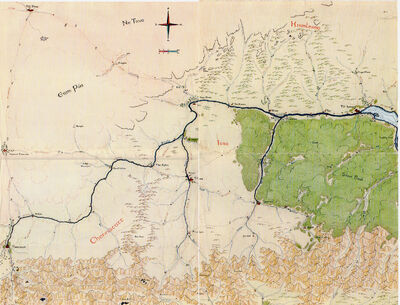
The Sîresha rose in the Tûr Betark, in the mighty Kiraskon Ravine, south of Ny-Cénnacatt, secret fortress of the Storm King. Meltwater from two glaciers, as well as the torrential rains falling on the mountain peaks, fed its upper reaches to create a fast- moving current. The yellowish color of the water was due to the yellow sediment or loess eroded from the cliffs of the Tûr Betark.
During Sadayn, the wettest season, a traveller following the foothills east from An-Balukkhôr had to detour north to the Mára Gaib (Ta. “Bridge of the Old-settlers”) to cross the flood-swollen Siresha. This remarkable engineering feat bridged the river at the narrowest point between Tartaust and Baud Selen. Dropping 224‘ through the Skara Riskál (Ta. “Wraith’s Teeth Rapids”), the river was joined at Tartaust by a small tributary and broadened to sweep smoothly along the bottom of a wide gorge. The current passed rapidly through chasms carved from mesas and rock outcroppings as well as across the vast plains of the scrubland typical of Cénnacatt. Just above Rásk, before the Maudar added its flow to the Siresha, the river dropped in the Skara Sársus (Ta. “Cougar’s Gullet Rapids”), the last of the white water that made the upper half of the Sîresha unnavigable. The lower Sîresha was a tamer stream, flowing between low banks and meandering in ever greater loops as it approaches the Bay of Ormal. It shrugged once more at the ruins of Cárnesra, where unusal rock formations in the river created lethal undercurents and an obstructed channel for water traffic. Young and daring adventurers sometimes braved the swirling current, but more prudent travellers and commercial bargemasters still used the old canal through the ruins to avoid the possibility of sinking their vessels. The great forest bordering Isra, the Sára Básk, grew right up to the river, its scrubby undergrowth and hardy trees overhanging the southern bank. Torbusaud (Ta. “Greenbarks”), slowed barges of herb pickers, patrolled this section of the Siresha to allow workers to efficiently harvest the wood’s bounty while still afloat. The lazy Sîrsis River flew between trunks of the famous bausk trees (known for their bizarely corkscrewed limbs) of the forest to join the Sîresha. The combined currents dumped into the Mard Isauba, a finger of the greater Bay of Ormal, at Tûl Harar.
